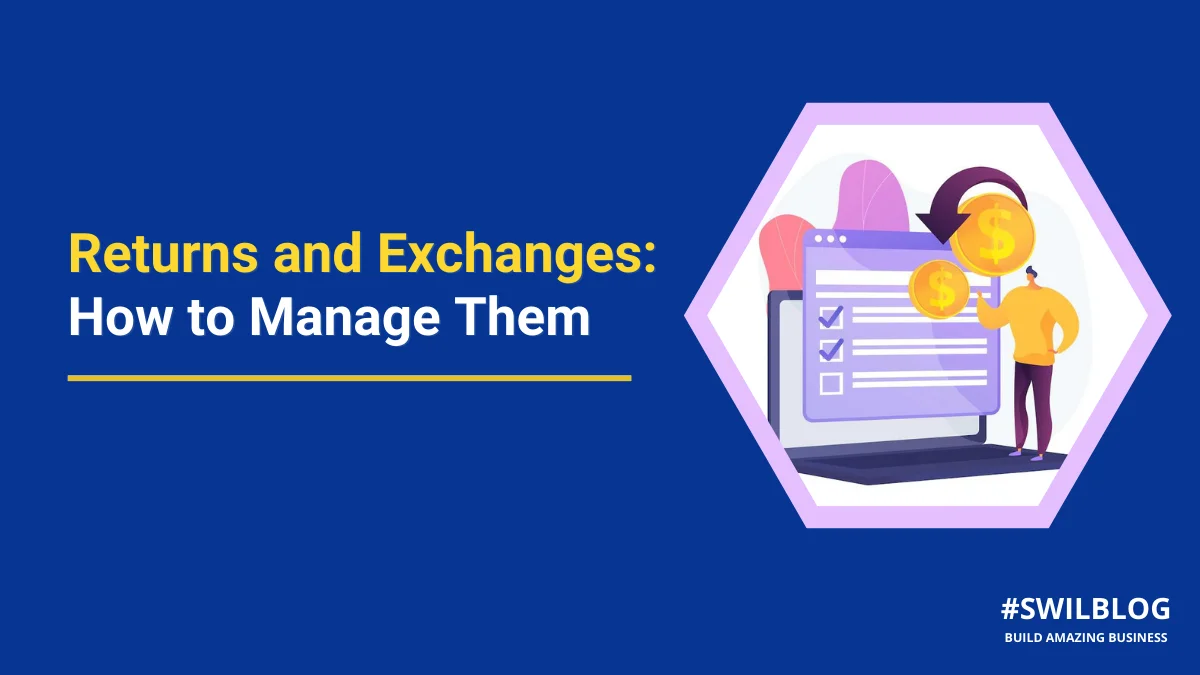Returns management is one of the most critical aspects of e-commerce. And for a good reason—a poorly managed returns process can cost your business a lot of money. This blog post will cover the basics of return management: what it is and why it’s so important.
We’ll also discuss how the return management process works and its different areas. Finally, we’ll give you tips on managing returns effectively so that you can avoid any costly issues down the road!
Article Content-
- What is the returns management process?
- Understanding Controllable and Uncontrollable Returns
- Why is return management critical?
- The Steps a Product Will Go Through in the Return Process
- Ways to Improve Your Return Management Process
- Frequently Asked Questions
- Conclusion
What is the returns management process?
Returns management is the process of tracking, recording, and managing returns. It helps ensure that customers are satisfied with their purchases and that the return process is as smooth as possible for all parties involved.
The return management process starts by finding out why the return was made. Once the reason for the return has been determined, the appropriate solution must be put in place.
This may include refunding the customer’s purchase price or offering a product or service adjustment.
If the customer is not satisfied with the return, the returns management process will help them to process the rescue in a way that is both polite and professional.
Understanding Controllable and Uncontrollable Returns
Returns and exchanges are an inevitable part of the investment game. Understanding the return management process and using it to your advantage is essential.
A return management process includes identifying potential risks and taking steps to protect against them. This process starts by understanding controllable returns and how factors like market conditions and timing influence them.
Once you know controllable returns better, you can focus on identifying and managing returns and exchanges.
On the other hand, uncontrollable returns include realized gains or losses on investments that cannot be predicted in advance. By using a return management process, you can take steps to mitigate the risk of any unexpected returns.
1. Controllable Returns
Returns management is a necessary process that helps businesses manage their returns effectively and efficiently. You can better organize your handling and streamline the return process by understanding the different return processes.
This, in turn, will help improve customer satisfaction while reducing processing time. There are three main types of returns: controllable, uncontrollable, and refunded with credits (RC).
Controllable returns can be processed quickly and easily, while those refunded with credits must typically go through additional inspection stages before they can be processed. Understanding which type of return will help speed up the process further.
Ultimately, by taking proper steps towards returning management, you’ll achieve superior customer satisfaction and control over business operations-two, valuable assets any company would want!
2. Uncontrollable Returns
Returns management is all about taking action when returns happen. This involves identifying the risks associated with each type of return, setting up processes and procedures to deal with them, and monitoring the situation closely.
It’s essential to be prepared for anything—from product damage that can’t be predicted to warranty claims that come in unexpected waves. Controllable returns can be expected and managed in advance—this is what businesses want most of the time!
Predicting returns helps companies avoid potential headaches caused by uncontrollable returns, like having a lot of customer service calls on hand or refund delays due to high demand for refunds.
Different types of controllable returns include shipping issues, faulty products, etcetera. Knowing which specific types of uncontrolled returns are most likely poses a massive advantage over competitors who might not have caught such incidents yet.
Why is return management critical?
Return management is an essential process for any business. It protects shareholder value and ensures customer satisfaction. By following a standardized process, you reduce the chances of mistakes and increase efficiency in your industry.
Furthermore, returns management can speed up the processing of exchanges, providing a better experience for customers.
So, make returns management a top priority and see its benefits on your bottom line and customer satisfaction.
1. Customer Retention:
It’s essential to keep your customers happy. Returns management can do just that by addressing these issues:
- Ensuring a return policy is in place allows you to process returns and exchanges quickly and easily.
- Clear return and exchange procedures will make the process smoother for both customers and retailers.
- Always ensuring all necessary information is readily available will go a long way in making returns feel like a breeze rather than an inconvenience!
2. Customer Satisfaction:
The key to a successful company is customer satisfaction. By constantly striving to please your customers, you can keep them coming back and ensure that they are happy with the product they receive and the process involved.
This will help maintain customer loyalty and increase sales in the long run. By following easy return procedures, you can cut down on customer dissatisfaction and fraud or theft, which could lead to lost revenue for your company.
In addition, proper returns management helps reduce inventory levels, saves time processing returns and exchanges, and ultimately boosts customer satisfaction even further!
3. Brand Loyalty:
Branding and customer loyalty go hand in hand. By providing returns and exchanges, businesses can help customers maintain their brand image while keeping the items they’ve bought as new.
In addition, returns can be processed more easily if systems are in place to track all the details related to them—from customer IDs to order numbers.
This way, you will know who has returned what and when!
The Steps a Product Will Go Through in the Return Process
Returns and exchanges can be a pain, but they’re necessary for the health of the customer base. Here are the steps a product will go through to be returned and exchanged:
1. The customer initiates the return, stating why they wish to return the item
If a customer wishes to return an item, followed by a customer service request explaining the reason for the return, then the process will be as follows:
- The product will be inspected, and if no damage is found, it will be put back on sale.
- If any damage is found, the product will not go back on sale, and a refund will be given to the original buyer.
2. The company either approves or disapproves of the return based on the reason stated by the customer
Returns are an essential part of customer service as they enable customers to get the products they have purchased in the wrong or faulty condition replaced or refunded.
Returns should be processed quickly and efficiently to keep the customer happy and satisfied. When returning products, the company must clearly define policies and procedures so that everything runs smoothly.
This includes setting return deadlines, inspecting returned items for damage, deducting appropriate amounts from returns, contacting the customer about return deadlines, etc.
3. Product picked by the agent
When a customer returns an item, the process starts with the customer’s request for a return. If the product doesn’t fall within the terms of the policy, it will be sent back to the customer for either a refund or an exchange.
After inspecting and determining if the product falls under the return policy, it is picked by the agent from the stock of products.
4. The item returns to the facility
Returns and exchanges are common customer service issues that businesses must take care of. Returns can be handled in several ways, depending on the product and the customer’s preference.
In most cases, the unused portion of the product will be returned to the facility for future returns or exchanges. If the product is not in its original condition, it will either be sent back to the customer or disposed of completely.
The process of returning or exchanging an item is always done with the utmost attention to detail to ensure satisfaction on both sides.
5. The product meets its destiny
Returns are essential to the retail experience for both customers and retailers. Here are five things you should know about returns: Returns usually happen when customers have a problem with the product they’ve bought.
The return process starts by contacting the retailer through email or phone calls.
- Once the retailer gets involved, they will issue a return authorization number (RA#) to help track and manage the process.
- Proof of purchase is always required—this could be a receipt or invoice.
- To process a return successfully, it is essential that all original packaging and accessories are included. The product must also be in its original condition—not used or damaged!
Ways to Improve Your Return Management Process
Returns management is necessary to ensure that customers are satisfied with their purchases. It’s important to review your return policy regularly to ensure that it’s implemented correctly and that returns are processed promptly and efficiently.
You can save time and energy using automation in your return management process. There are various ways to improve return management, so find the best approach.
For example, you can track your sales and use data to make better decisions about when and how to exchange products. Doing this can ensure that your customers are happy and that you’re maximizing the return value of the products you sell.
1. Transparent Refund Policy
It is essential to have a transparent refund policy that customers can understand and feel comfortable with. You can make the necessary adjustments in your return/exchange process by tracking returns and exchanges.
Let your customers know about discounts or offers on returns and exchanges is also beneficial.
Lastly, set up an easy-to-use policy that makes the whole process as smooth as possible for both the customer and the business.
2. Finalize cost of returning a product
Returns are an inevitable part of any business, but handling them should not be a hassle for either customer or the company. Following the tips outlined in this article, returns can be processed smoothly and within the agreed timeframe.
Furthermore, setting up an RMS will help streamline return management processes and keep track of everything happening with them.
Lastly, making returns easy for customers is essential by providing clear return instructions and policies. This will reduce the number of returns filed and improve customer satisfaction ratings!
3. Analyze your returns
It would help if you kept a few things in mind regarding returns.
- You need to appoint someone who will be responsible for the process—this person can be your Returns Coordinator.
- Ensure returned products’ records and the customer’s contact information to make follow-up easy and hassle-free.
- Set up a returns management process so that all returns get adequately processed and tracked.
- Ensure you have the appropriate refund policies—this will help reduce administrative work and improve customer satisfaction.
4. Expedite your return process
Returns are an essential part of the customer experience, and returns must be processed quickly and smoothly to ensure customers have a positive experience. Here are four simple tips to expedite your return process:
- Maintain accurate records of all exchanges so you can analyze them and improve your process the next time!
- Make sure you have a return policy and follow it carefully.
- Keep track of your returns and exchanges systematically. This will help reduce the number of administrative tasks involved in processing returns, making the entire process faster for everyone concerned.
- Handle returns quickly and efficiently to avoid delays or inconvenience to your customers; this will help to increase customer loyalty!
Frequently Asked Questions
1. Check the My Returns tab in your account to determine what products and quantities can be returned.
2. Review the conditions of returns on our website. We require the original packaging, and all parts that arrived with the product must also be included with the return shipment.
3. Contact Customer Service by phone or chat support via our website portal to initiate a return request. A customer service representative will help you complete the process and provide instructions for shipping your items back to them.
Returns should be accepted within 30 days of receiving the product, and exchanges should be accepted within 14 days.
The three stages of returns and exchanges are the acquirer’s return, the return process, and the return shipping.
Conclusion
Returns management is an essential process that helps businesses manage returns and exchanges safely, efficiently, and customer-centric manner.
Start practicing the returns management process by understanding the controllable and uncontrollable returns and why returns management is essential. Check back for more helpful tips on return management shortly!








